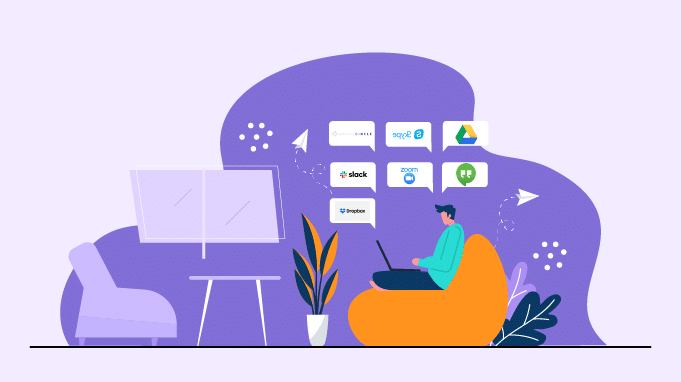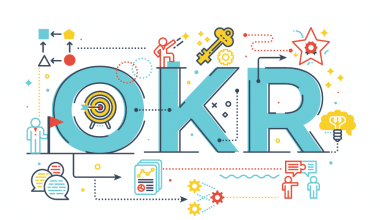Remote work tools, as a broad category of software tools and apps used to boost productivity while working from home, can range from as simple as a chat application to complete ecosystems such as digital workplace platforms. They are digital tools that enable remote workers to collaborate, communicate, transact, and complete tasks with their managers and colleagues from wherever they are located. Having so many options in the market, we have put together a list of the best remote work tools with both paid and free options for you.
The Best Remote Work Tools Available For You
#1. Trello
Trello is a popular tool among startups. It’s a general-purpose, user-friendly project management application based on the Kanban system.
It also makes it simple for managers to design cards and guide employees through a lean process that can be as customized as they like.
Trello’s success stems from its visual list generation tool, which allows you to track project progress in a straightforward and visual manner.
You can delegate tasks, track progress, collect and store information, and plan and organize work processes by creating and rearranging task cards.
#2. Slack
Slack is an easy-to-use chat/channel communication solution with a user-friendly UI that can keep everyone connected.
It can work with other applications such as G Suite, Dropbox, Adobe Creative Cloud, and others. Slack bots that provide birthday reminders and team reports enhance morale.
It’s difficult to picture a distant team collaborating without Slack.
Even its motto, “Where work happens,” emphasizes its importance in project management.
Slack is available in both mobile and online versions, allowing users to work and coordinate from anywhere.
Its low cost and practical qualities make it an excellent communication tool for many distant software development teams.
#3. Zoom
Zoom is a lightweight video conferencing program that connects straight into Google Calendar.
Despite having messaging options, Zoom is best recognized for its high-quality video calling.
You can get 40 minutes of conferencing time with the free plan. And with a pro subscription, you get much more, like webinar hosting features, which may be extremely beneficial to your online marketing efforts.
Video recordings are one of the most popular features among users. These recordings can be used to make educational movies or to chronicle typical practices.
#4. Dropbox
Dropbox is a cloud-based file hosting service that allows users to centralize their data and make it available to whomever they choose.
It’s an online library for organizing and managing material such as papers, images, movies, music, or any of the other dozen file types supported by Dropbox.
It is compatible with a wide range of devices and may be viewed by computer or mobile device.
Dropbox’s free version gives you 2 GB of cloud storage space, but if you need more capacity, you should explore its commercial editions, which start at $8.25 per month.
#5. Asana
Asana has been around since 2008 and has a plethora of features that make it highly strong.
It is a comprehensive toolkit with a solution for any organization’s needs, from timelines and project boards to automation and connectors.
The task-oriented UI of Asana makes it a fantastic tool for remote job management.
Its job assignments are integrated into larger projects, allowing team members to compartmentalize their burden during the development process.
Its simple design allows you to follow progress and understand who is responsible for certain project sections, reducing the likelihood of confusion over roles and responsibilities.
#6. Redbooth
Redbooth is a web-based collaboration solution for task management in teams.
It centralizes all of its features to facilitate communication and advanced project management.
Customers from different industries have praised Redbooth, making it a formidable competitor to Asana and Basecamp.
#7. Basecamp
Through its simple layout and practical task items, Basecamp has earned the trust of its consumers.
Due dates, calendaring, and to-do lists assist users in setting priorities and organizing their work based on the importance of the assigned tasks.
Message boards, group chats, and automated check-ins ensure that everyone on the team keeps in touch.
Team members can communicate in real-time using Basecamp from the comfort of their laptops or mobile devices.
#8. Milanote
Milanote is a program for arranging creative tasks into visually appealing boards.
By design, it should feel similar to working on the wall in a creative studio – visible, tactile, and occasionally a little sloppy. This makes it an ideal tool for designers working in distributed teams.
It includes hundreds of built-in templates to help you get started on a variety of projects, from designing a mood board to crafting the perfect creative brief.
Milanote boards provide a private space to think by default, but you may build a shared workspace for collaboration with your team with a single click.
Milanote’s primary features include the ability to create notes and to-do lists, upload photographs and files, and preserve information discovered on the internet. It also allows you to organize visually with a drag-and-drop interface.
What Are The Best Free Tools For Remote Work?
The best free remote work tools enable your team to remain productive, accountable, and connected. They not only provide employees with the resources they need to be effective when working outside the office, but they are also free, which is crucial for small firms watching their bottom line. Here are the best free and paid remote work tools available for you.
#1. Slack
Slack is a platform for instant messaging that organizes conversations into shared channels, allowing organizations to interact with team members from all over the world.
The tool provides a free tier that small organizations can utilize indefinitely. It gives you access to 10,000 of your team’s most recent messages, as well as one-on-one phone and video chats between peers and up to ten integrations with other programs like Google Drive and Office 365.
Small firms that hold online meetings on a regular basis might consider the premium Slack option. Identity protection features have been implemented, as well as full interaction with Slack tools. There is also a message history saved. Slack’s premium package secures team meetings and conversations without time constraints.
#2. Zoom
Zoom is a remote video conferencing service that can link your team via video chat, conference rooms, and phone conversations. No matter where you are, the service delivers online meetings, video webinars, cross-platform messaging, and file sharing.
The basic Zoom plan is free and covers up to 100 participants as well as limitless one-on-one meetings. This plan allows groups of three or more to meet for up to 40 minutes at a time. In addition to HD video and voice, full-screen and gallery view, simultaneous screen share, and Chrome and Outlook plugins, the free basic plan offers. It is compatible with Mac, Windows, Linux, iOS, and Android operating systems.
To facilitate virtual communications, many distant professionals choose Zoom’s premium version. The time limit is one of the most significant disadvantages of Zoom’s free version. Many businesses find it difficult to keep meetings to less than 40 minutes. Meeting times are limitless with the premium plan. Paid options also include cloud storage for meetings and social media streaming.
#3. Microsoft Teams
Microsoft Teams is an Office 365 communication center that integrates workplace chat, video conferencing, cloud storage, and app integration. The tool is available for free download until January 20, 2021.
Remote teams enjoy unlimited chat, built-in group and one-on-one audio or video calling, 10GB of team file storage, and 2GB of personal file storage per user with Microsoft Teams’ free version. If your company has an Office 365 subscription, you already have access to Microsoft Teams.
#4. Convene
Convene provides additional assistance for virtual meetings, such as interactive Q&As and polling tools. Meetings of up to two to four hours in length can be held every day, with breakout rooms available. The highest tier offers granular analytics to assist you in assessing guest participation.
#5. HubSpot Meetings
You can sync your Google Calendar or Office 365 calendar with HubSpot Meetings, establish your availability, and have customers or staff schedule meetings with you. To save contact information, the tool includes form fields for your meeting page. You can also email the meeting page as a link or embed it on your website. You may use HubSpot Meetings for free and host an unlimited number of meetings.
#6. Setmore
Setmore is an appointment scheduling solution that helps you organize your calendar, customer lists, booking page, and employee profiles. This service allows you to access all of your appointments from anywhere in the world, allowing your staff and customers to reschedule directly from their inboxes, saving you time on time-consuming phone calls.
The free basic plan from Setmore provides up to four staff logins and calendars, as well as automated alerts and notifications. You can utilize the service to book customer appointments online. Third-party apps and platforms like as Facebook, Mailchimp, Zendesk, and Zapier are also integrated into the free basic plan.
#7. 10 to 8
Because more people are working from home, the appointment and scheduling program 10 to 8 has grown in popularity. There is a free version, however you are limited to two staff logins and 100 appointments per month. Paid options allow for two or more staff logins per month as well as 100, 300, 600 (or a custom number) appointments every month. Paid versions can also be branded with your company’s logo.
#8. Basecamp
Basecamp is a management solution that centralizes everything your team needs to get work done. Your team will have access to message boards, to-do lists, file storage, real-time group chat, and automated check-in questions inside each project. Basecamp may also connect to third-party mobile and desktop programs like TaskClone, Zapier, Project Buddy, and Zoho Flow.
Basecamp Personal is a free plan designed for individuals and small teams. The plan allows for three independent projects and up to 20 participants, as well as 16GB of cloud storage.
The majority of users chose Basecamp Business for their business requirements. This subscription plan allows for an unlimited number of features and users. A large quantity of storage space is also included in the subscription plan, which is required to keep the workflow running. This also ensures that you may access saved projects for as long as you need to.
#9. Asana
Asana is a project and task management platform that may help your team organize, track, and manage their work from anywhere. Its automation capabilities eliminate bottlenecks, streamline approvals, convert standard projects into custom templates, and save you time changing project schedules manually when deadlines change.
Asana has a free basic plan for up to 15 team members that features calendar and list views and allows you to set tasks and due dates. Third-party programs such as Jira Cloud, Adobe Creative Cloud, Gmail, and Slack are integrated into the free plan.
Work From Home Productivity Tools for Teams
#1. Monday.com
It couldn’t be easier to manage progress, resources, and workflows remotely. Monday.com’s cloud-based, one-stop-shop project management software tracks, charts, and prioritizes all timeframes. This information hub provides all of your staff with real-time access to the most up-to-date information, whether they are in Paris, TX or Paris, France, ensuring that everyone understands their task.
Monday.com’s template menu eliminates the need to constantly reinvent the wheel. They also provide a plethora of modifications, notifications, and reporting widgets to help you consolidate your complete company profile into one simple project management solution.
#2. Assembly
If “time is money,” why not make the most of both? Assembly is trusted by over 3000 businesses for workflow management, employee appreciation, project monitoring, and much more. Having everything you need under one roof to manage your remote staff saves you both time and money.
Assembly’s major goal is to assist you and your staff “work smarter, not harder,” and they give employee surveys so you can always have a pulse on your teams.
#3. Bonusly
Bonusly’s cross-functional platform engages remote employees by empowering them to publicly and monetarily(ish) appreciate one another. Rewards points can be given as recognition among coworkers, elevating appreciation to a new degree of importance. Their adjustments and alternatives ensure that they will fit your corporation.
Employees can use their reward points to buy branded merchandise, travel and experiences, and a plethora of other things.
Companies that use this software to increase WFH productivity include:
#4. Favro
Favro has tools and automations to accommodate every business, no matter how big or little. Many of their options and capabilities can really replace a variety of software platforms and apps you’re presently using, optimizing your procedures instantaneously.
Favro focuses on ensuring that your organization can operate with the three As – agility, autonomy, and alignment. A winning combo for making your workflow go more smoothly.
#5. Kazoo
It might be difficult to achieve organizational alignment. Kazoo, thankfully, has an app for that…literally. Create your whole office management platform in one place, measure engagement, incentivise top employees, and reward recognizable behaviors.
Kazoo mobilizes your whole employee experience platform, allowing you to perform everything from nearly anywhere.
#6. Nectar
Developing a strong company culture begins with acknowledging the talented people who keep the company running. Nectar provides sophisticated incentive and recognition programs, as well as a vast selection of incentives that your employees will appreciate. Their 360° platform is ideal for enhancing employee morale and productivity from any location.
There are several ways for your employees to earn points and equally numerous ways for them to spend them. It is simple to incorporate into your onboarding experience and work-from-home policy, allowing all employees to embrace it quickly and efficiently.
#7. Empuls
Empuls provides a comprehensive toolset of engagement, connection, and rewards programs to help enhance productivity among your remote team members. Their platform was designed to improve the work experience for all employees, regardless of location.
The Empuls platform is a full-circle communication tool that includes excellent staff surveys, so you’re always aware of what’s working and where you can improve.
#8. Collaboration
It’s never been easier to keep everyone informed and involved. With a plethora of built-in tools and tactics, teamwork improves your internal and external connectivity. Maintain a clear view of project schedules and never miss another deadline.
Keeping participants and duties prioritized and reportable throughout the whole project period increases employee productivity significantly.
#9. Kallidus
The best and brightest skills build successful enterprises. Kallidus has been assisting organizations like yours in creating long-term employee connections by attracting, developing, and retaining the greatest fit for every role for over 20 years.
The measurements are spot on! From the receiving of an employee’s resumé through their retirement date, and every step of their growth and success in between, keep track of everything.
Is Zoom a Remote Work Tool?
Yes, Zoom is a remote working tool.
Why Are Remote Working Tools Important?
Remote work tools enable small business teams to remain productive, accountable, and connected while working away from home.
Why Is Remote Work A Problem?
Managing your to-do list might be difficult when you work from home and have a flexible schedule and distractions.
Conclusion
The new style of working includes video calls, screen sharing, and Zoom presentations. Home office productivity tools help to address the gaps left by the shift to hybrid and remote work. Your employees, just like they do in the workplace, require the correct programs and tools to be productive. We hope you find the tools in this article helpful.
Related Articles
- ZOOM LOGO: History, Rebranding, Meaning & Invaluable Business Tips
- CONTACT CENTER: Meaning, Benefits and Types
- Communication Tools for Business: Meaning, Uses & 2023 Best Options
- ZOOM FEATURES: Meaning, Pricing, and How to Use It






